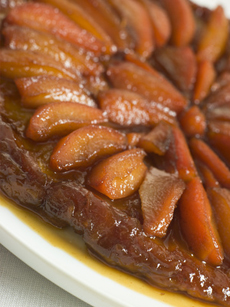
A quince tart tatin. Photo © Monkey Business | Fotolia.
November 2011
Last Updated November 2018
|
 |
Recipe: Quince Tart Tatin
Turn A Hard Fall Fruit Into A Silky Dessert
Introduction To Quince
The tree of knowledge in the Garden of Eden may have been quince, not apple.
The book of Genesis does not name the specific type of the fruit that Eve picked and shared with Adam. Cultivation of quince may have preceded apple cultivation, and many early references that have been translated as “apple” may in fact have been quince.
The apple originated in Central Asia, the area that extends from the Caspian Sea in the west to China in the east, from Afghanistan in the south to Russia in the north.
The quince is native to the Caucasus, not that far away. The Caucuses are a mountain range that separates Europe and Asia. The region spans the border of Eastern Europe and Western Asia, between the Black Sea and the Caspian Sea. It includes the modern countries of Russia, Georgia, Azerbaijan and Armenia.
Botanically,
quince is related to both the apple and the pear. It looks like a combination of the two—a large, lumpy pear. The fruit can easily grow to six inches in length. The plural form of the word is the same as the singular—quince, not quinces.
Most varieties of quince are too hard and astringent to be eaten raw. Instead, they are used to make jam, jelly, quince pudding, pies and tarts.
The word “marmalade,” which originally meant quince jam, derives from “marmelo,” the Portuguese word for quince).
Buying & Storing Quince
Choose quince that are hard and firm. Although the fruit may have bruise marks, they usually do not affect the quality.
Store quince in a plastic bag in the refrigerator; they’ll keep for several weeks. Once ripe, the skin will turn from green to yellow, but the fruit will still be firm (and in need of cooking).
Quince should always be peeled before cooking.
Adding a dice of quince to applesauce and apple pies enhances the flavor and texture. The white flesh turns red after a long cooking time.
RECIPE: QUINCE TARTE TATIN
This recipe is courtesy one of our favorite chefs, Charlie Palmer.
Ingredients
- 4 cups white wine
- 2 cups water
- 4 stems basil
- 1 teaspoon black peppercorns
- 1 teaspoon orange zest
- 1/2 teaspoon cloves
- 4 quince
- 1 cup sugar
- Water (as needed)
- 3 tablespoons butter
- 1 puff pastry round cut into a 9-inch diameter
Preparation
- Add the white wine, sugar, basil, peppercorns, orange zest, and cloves to a large enough pot to accommodate all of these ingredients and the quince. Bring the liquid to a simmer.
- Peel the quince fruits and add to the pot, placing a plate on top to keep them submerged. Poach for 30 minutes, and then allow them to cool in their poaching liquid.
- Remove the quince from their liquid, cut into sixths, remove the core, and set aside. Strain the poaching liquid and reserve.
- Preheat oven to 400°F.
- In a medium, oven-proof sauté pan (9 inches), add the sugar, mixed with just enough water to form a wet sand consistency. Place over a medium flame on the stove. When the mixture has reached a caramel consistency and a deep golden color, remove from the heat and whisk in the butter.
- Carefully lay the slices of quince into the caramel, slightly overlapping each one so that the bottom of the pan is no longer visible.
- Place the puff pastry over the quince and then set the entire pan in the oven. After approximately 10 minutes, the puff pastry will have puffed and become slightly golden around the edges. Reduce the temperature of the oven to 300 degrees and cook for an additional 15-18 minutes, or until the puff pastry is well colored and cooked through.
- Remove the tart from the oven and let sit for at least 5 minutes, or until ready to serve. If the tart is prepared well in advance of serving, warm the bottom over low heat and then place in a low oven to reheat before turning out.
- Place an inverted plate atop the tart and carefully but quickly flip the entire pan over to turn out the tart onto the plate. Cut into wedges and serve with vanilla ice cream or whipped cream.
Thanks to Melissas.com and Charlie Palmer for sharing this recipe with us.
Recipe © Copyright Charlie Palmer. Other material

|


